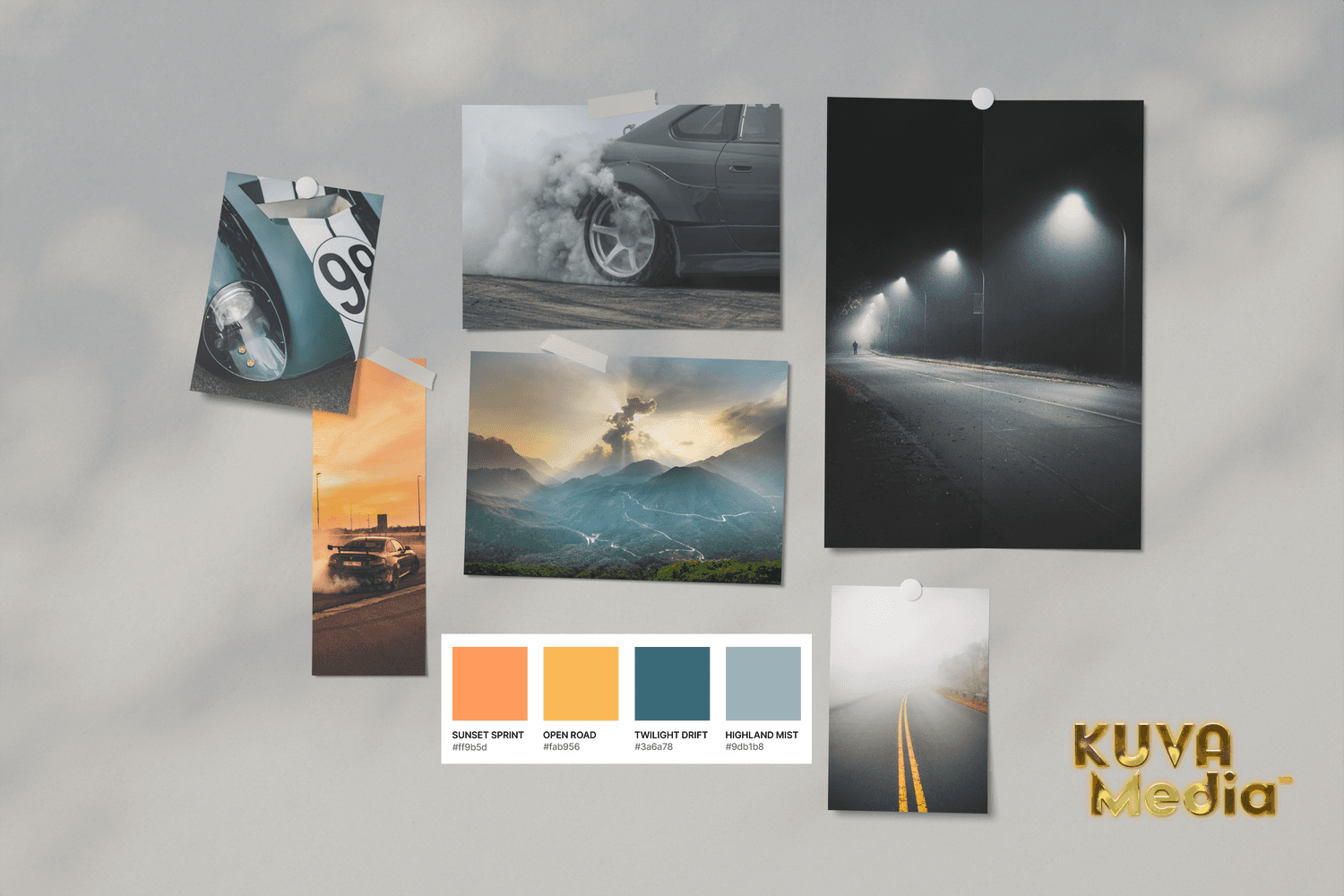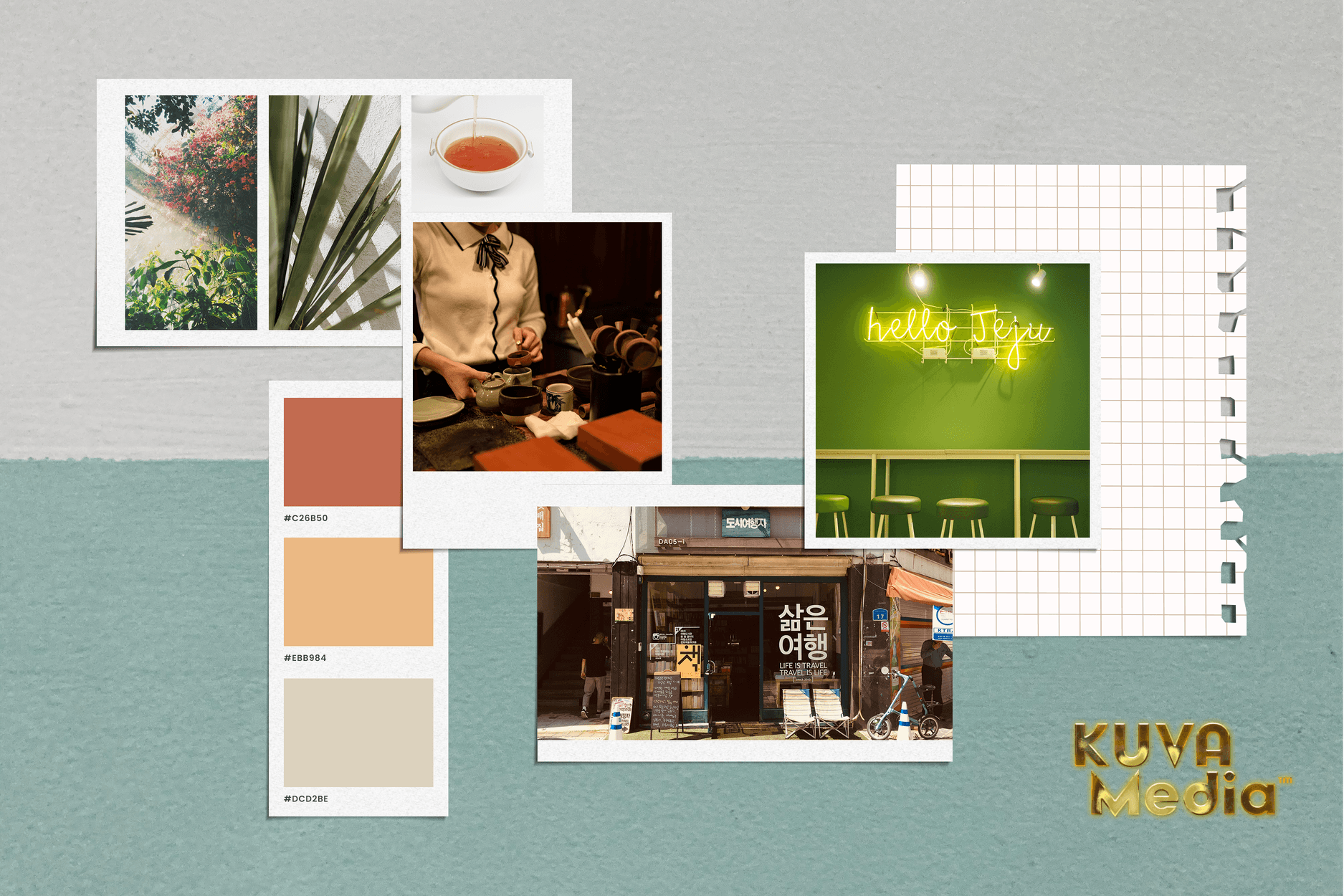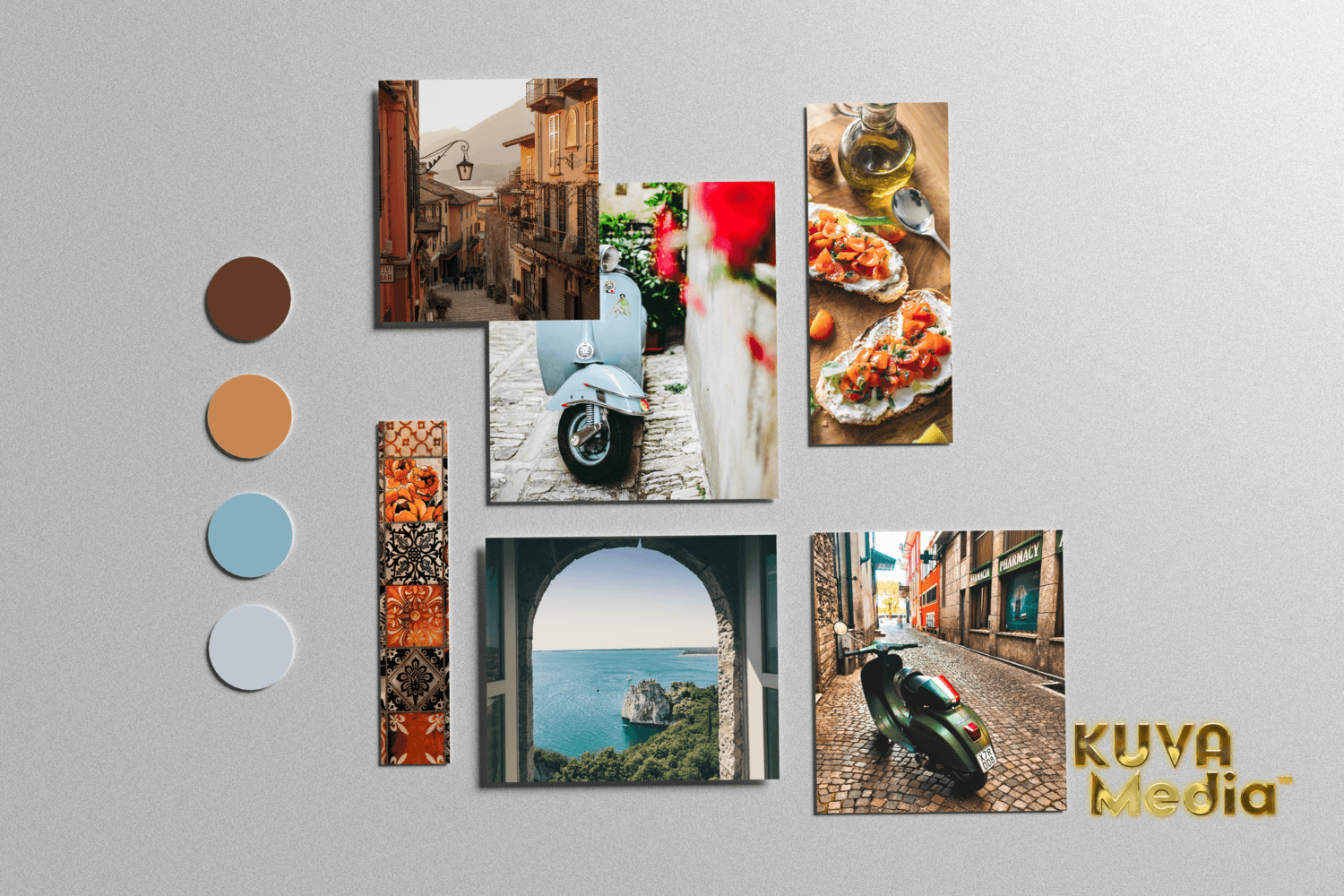How to Start a Successful Branding or Design Project with a Mood Board, In Only 5 Steps
How to Start a Successful Branding or Design Project with a Mood Board, In Only 5 Steps
How to Start a Successful Branding or Design Project with a Mood Board, In Only 5 Steps




Starting a branding project can be both an exciting and daunting task, especially for beginners. Whether you're launching a new business or rebranding an existing one, the goal is to create a brand identity that resonates with your target audience to attract them, and stands out in the market. But where do you start? Enter the mood board—a powerful tool that can help bridge the gap between your vision and the final brand identity. Bookmark or print this checklist for your next branding project!
✦ Want to get the details for Kuva Media's favorite free apps to use for making mood boards? Send us a message of "mood board app" in the chat, and we'll send it over!
What is a Mood Board?
A mood board is a visual representation of your brand's essence. It's a collection of images, color palettes, typography, and other visual elements that together convey the vibe and aesthetic you envision for your brand.
Think of it as a visual compass that guides you and your design team throughout the branding journey, ensuring that everyone is aligned on the brand's direction.
Here is an example of a mood board:

Mood board can curate colors, textures, feelings and emotions, times, geographic locations, and so much more.
Why Mood Boards Matter
Mood boards are more than just pretty collages; they're communication tools. They make abstract ideas tangible, providing a clear vision of what you're aiming for with your brand.
This clarity is crucial not only for guiding your design team but also for ensuring that the final brand identity targets your ideal clients and embodies your brand's values.
Within the design process for branding, mood boards can often cut down on number of revisions, and lessen miscommunication about visual styles.
The Checklist for Creating Effective Mood Boards
To help you create a mood board that effectively communicates your brand's vision, here's a step-by-step guide from the Kuva Media team:
1. Gather Inspiration
Action: Start collecting images, color schemes, fonts, and any visual elements that you feel capture the essence of your brand. Look for inspiration in uncommon places.
Most people are not professional designers or brand strategists, and tend to think in literal terms when creating visual identities. This could look like a law firm choosing visuals like stark, steely offices, and photos of people in suits shaking hands.
But, does that truly represent this specific brand, or just look like every other law firm's generic branding? What happens when you dig deeper, to the essence of the law firm's mission for it's clients? This could result in selecting mood board images with colors and textures like:Burnished copper to represent toughness, with style
A vacation photo of a new day's sun peaking over mountains, to represent the warm promise of a better tomorrow
A screenshot of the exact ink used to sign that law firm's first ever settlement agreement for their client (signature and confidential details redacted, of course)
Inspiration is not only endless, but unique to every brand. What is yours?
Why: These elements serve as the building blocks of your mood board, each contributing to the overall visual vibe you want to achieve. This will later affect your final choices for colors, typography and more, for use in things like your email signature, stationery, social media, and other marketing.

2. Think About Your Audience
Action: Include elements that will appeal to your target demographic. Consider their preferences, lifestyles, and expectations.
And don't forget psychographics. How does your brand want to appeal to specific goals, dreams, pain points, values, thinking and decision-making styles, and more?
Lastly, you'll want to think about who your audience is not. While focusing on your target audience, you'll want to make sure that you avoid targeting audience segments that may not be what your brand is targeting.Why: Your brand doesn't exist in a vacuum; it needs to connect with people. Tailoring your mood board to your audience ensures that your brand identity will resonate with them, and ultimately attract them.
3. Consider Your Brand Values
Action: Make sure the mood board reflects your brand’s core values and message. This can include anything from sustainability to luxury to innovation.
Why: Your brand's values are its heart and soul. A mood board that embodies these values helps ensure that your brand identity does too.
4. Aim for Variety and Balance
Action: Mix different textures, colors, and forms in your mood board but strive to keep the overall look cohesive.
Why: Variety adds depth and interest, while balance maintains a sense of unity. Together, they make your mood board—and by extension, your brand—more compelling.

5. Engage in a Feedback Loop
Action: Share your mood board with colleagues, friends, or even potential customers. Gather their thoughts and be open to making adjustments.
Why: Feedback can provide new insights, help you catch oversights, and refine your vision, making your mood board a stronger foundation for your brand identity.
Ready to control your brand's future?
See Kuva Media's portfolio and demos.
Starting a branding project can be both an exciting and daunting task, especially for beginners. Whether you're launching a new business or rebranding an existing one, the goal is to create a brand identity that resonates with your target audience to attract them, and stands out in the market. But where do you start? Enter the mood board—a powerful tool that can help bridge the gap between your vision and the final brand identity. Bookmark or print this checklist for your next branding project!
✦ Want to get the details for Kuva Media's favorite free apps to use for making mood boards? Send us a message of "mood board app" in the chat, and we'll send it over!
What is a Mood Board?
A mood board is a visual representation of your brand's essence. It's a collection of images, color palettes, typography, and other visual elements that together convey the vibe and aesthetic you envision for your brand.
Think of it as a visual compass that guides you and your design team throughout the branding journey, ensuring that everyone is aligned on the brand's direction.
Here is an example of a mood board:

Mood board can curate colors, textures, feelings and emotions, times, geographic locations, and so much more.
Why Mood Boards Matter
Mood boards are more than just pretty collages; they're communication tools. They make abstract ideas tangible, providing a clear vision of what you're aiming for with your brand.
This clarity is crucial not only for guiding your design team but also for ensuring that the final brand identity targets your ideal clients and embodies your brand's values.
Within the design process for branding, mood boards can often cut down on number of revisions, and lessen miscommunication about visual styles.
The Checklist for Creating Effective Mood Boards
To help you create a mood board that effectively communicates your brand's vision, here's a step-by-step guide from the Kuva Media team:
1. Gather Inspiration
Action: Start collecting images, color schemes, fonts, and any visual elements that you feel capture the essence of your brand. Look for inspiration in uncommon places.
Most people are not professional designers or brand strategists, and tend to think in literal terms when creating visual identities. This could look like a law firm choosing visuals like stark, steely offices, and photos of people in suits shaking hands.
But, does that truly represent this specific brand, or just look like every other law firm's generic branding? What happens when you dig deeper, to the essence of the law firm's mission for it's clients? This could result in selecting mood board images with colors and textures like:Burnished copper to represent toughness, with style
A vacation photo of a new day's sun peaking over mountains, to represent the warm promise of a better tomorrow
A screenshot of the exact ink used to sign that law firm's first ever settlement agreement for their client (signature and confidential details redacted, of course)
Inspiration is not only endless, but unique to every brand. What is yours?
Why: These elements serve as the building blocks of your mood board, each contributing to the overall visual vibe you want to achieve. This will later affect your final choices for colors, typography and more, for use in things like your email signature, stationery, social media, and other marketing.

2. Think About Your Audience
Action: Include elements that will appeal to your target demographic. Consider their preferences, lifestyles, and expectations.
And don't forget psychographics. How does your brand want to appeal to specific goals, dreams, pain points, values, thinking and decision-making styles, and more?
Lastly, you'll want to think about who your audience is not. While focusing on your target audience, you'll want to make sure that you avoid targeting audience segments that may not be what your brand is targeting.Why: Your brand doesn't exist in a vacuum; it needs to connect with people. Tailoring your mood board to your audience ensures that your brand identity will resonate with them, and ultimately attract them.
3. Consider Your Brand Values
Action: Make sure the mood board reflects your brand’s core values and message. This can include anything from sustainability to luxury to innovation.
Why: Your brand's values are its heart and soul. A mood board that embodies these values helps ensure that your brand identity does too.
4. Aim for Variety and Balance
Action: Mix different textures, colors, and forms in your mood board but strive to keep the overall look cohesive.
Why: Variety adds depth and interest, while balance maintains a sense of unity. Together, they make your mood board—and by extension, your brand—more compelling.

5. Engage in a Feedback Loop
Action: Share your mood board with colleagues, friends, or even potential customers. Gather their thoughts and be open to making adjustments.
Why: Feedback can provide new insights, help you catch oversights, and refine your vision, making your mood board a stronger foundation for your brand identity.
Ready to control your brand's future?
See Kuva Media's portfolio and demos.
Starting a branding project can be both an exciting and daunting task, especially for beginners. Whether you're launching a new business or rebranding an existing one, the goal is to create a brand identity that resonates with your target audience to attract them, and stands out in the market. But where do you start? Enter the mood board—a powerful tool that can help bridge the gap between your vision and the final brand identity. Bookmark or print this checklist for your next branding project!
✦ Want to get the details for Kuva Media's favorite free apps to use for making mood boards? Send us a message of "mood board app" in the chat, and we'll send it over!
What is a Mood Board?
A mood board is a visual representation of your brand's essence. It's a collection of images, color palettes, typography, and other visual elements that together convey the vibe and aesthetic you envision for your brand.
Think of it as a visual compass that guides you and your design team throughout the branding journey, ensuring that everyone is aligned on the brand's direction.
Here is an example of a mood board:

Mood board can curate colors, textures, feelings and emotions, times, geographic locations, and so much more.
Why Mood Boards Matter
Mood boards are more than just pretty collages; they're communication tools. They make abstract ideas tangible, providing a clear vision of what you're aiming for with your brand.
This clarity is crucial not only for guiding your design team but also for ensuring that the final brand identity targets your ideal clients and embodies your brand's values.
Within the design process for branding, mood boards can often cut down on number of revisions, and lessen miscommunication about visual styles.
The Checklist for Creating Effective Mood Boards
To help you create a mood board that effectively communicates your brand's vision, here's a step-by-step guide from the Kuva Media team:
1. Gather Inspiration
Action: Start collecting images, color schemes, fonts, and any visual elements that you feel capture the essence of your brand. Look for inspiration in uncommon places.
Most people are not professional designers or brand strategists, and tend to think in literal terms when creating visual identities. This could look like a law firm choosing visuals like stark, steely offices, and photos of people in suits shaking hands.
But, does that truly represent this specific brand, or just look like every other law firm's generic branding? What happens when you dig deeper, to the essence of the law firm's mission for it's clients? This could result in selecting mood board images with colors and textures like:Burnished copper to represent toughness, with style
A vacation photo of a new day's sun peaking over mountains, to represent the warm promise of a better tomorrow
A screenshot of the exact ink used to sign that law firm's first ever settlement agreement for their client (signature and confidential details redacted, of course)
Inspiration is not only endless, but unique to every brand. What is yours?
Why: These elements serve as the building blocks of your mood board, each contributing to the overall visual vibe you want to achieve. This will later affect your final choices for colors, typography and more, for use in things like your email signature, stationery, social media, and other marketing.

2. Think About Your Audience
Action: Include elements that will appeal to your target demographic. Consider their preferences, lifestyles, and expectations.
And don't forget psychographics. How does your brand want to appeal to specific goals, dreams, pain points, values, thinking and decision-making styles, and more?
Lastly, you'll want to think about who your audience is not. While focusing on your target audience, you'll want to make sure that you avoid targeting audience segments that may not be what your brand is targeting.Why: Your brand doesn't exist in a vacuum; it needs to connect with people. Tailoring your mood board to your audience ensures that your brand identity will resonate with them, and ultimately attract them.
3. Consider Your Brand Values
Action: Make sure the mood board reflects your brand’s core values and message. This can include anything from sustainability to luxury to innovation.
Why: Your brand's values are its heart and soul. A mood board that embodies these values helps ensure that your brand identity does too.
4. Aim for Variety and Balance
Action: Mix different textures, colors, and forms in your mood board but strive to keep the overall look cohesive.
Why: Variety adds depth and interest, while balance maintains a sense of unity. Together, they make your mood board—and by extension, your brand—more compelling.

5. Engage in a Feedback Loop
Action: Share your mood board with colleagues, friends, or even potential customers. Gather their thoughts and be open to making adjustments.
Why: Feedback can provide new insights, help you catch oversights, and refine your vision, making your mood board a stronger foundation for your brand identity.
Ready to control your brand's future?
See Kuva Media's portfolio and demos.
Join the Insider's List
Get our high-value marketing, design, and business digest. No spam 🤍 We never sell data.
Resources
Clients
Join the Insider's List
Get our high-value marketing, design, and business digest. No spam 🤍 We never sell data.
Resources
Clients
Join the Insider's List
Get our high-value marketing, design, and business digest. No spam 🤍 We never sell data.
Resources
Clients
Join the Insider's List
Get our high-value marketing, design, and business digest. No spam 🤍 We never sell data.
Resources
Clients














